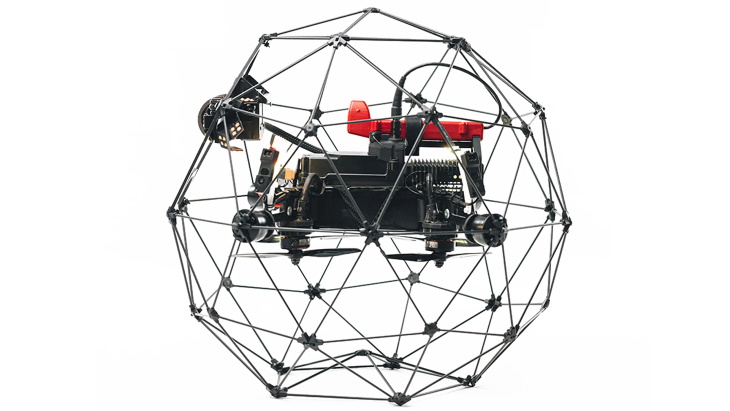New drone for mapping radiation in nuclear plants
Swiss drone developer Flyability has launched an indoor drone equipped with a radiation sensor specifically for conducting inspections at nuclear facilities. The Elios 2 RAD is designed to help maintain low radiation exposure levels to nuclear facility workers. It does this both by taking the place of personnel where possible for visual and radiation data collection, and by providing high-quality data for planning interventions that do require exposure, so that it can be kept to a minimum.

The Elios 2 RAD drone (Image: Flyability)
Equipped with an energy compensated Geiger-Muller detector, the Elios 2 RAD can detect radiation while in flight through Flyability's piloting app. The drone is supplied with three sensors capable of measuring dose rates within a range of 3 microsieverts per hour to 10 sieverts per hour. After the inspection flight, nuclear engineers can use Flyability's Inspector 3.0 software to map the radiation along the flight path of the drone, showing the exact location of dangerous dose levels within a nuclear facility. They can also play back the inspection flight within Inspector 3.0, using it to see dose rate measurements displayed synchronously on top of the video footage.
According to Flyability, the Elios 2 RAD can be quickly deployed from a non-contaminated area to evaluate risks and dangers in case of a leakage or incident. When planning interventions, the drone can be used to estimate the total dose workers would be exposed to and identify hot-spots to minimise human exposure. It can also be used to evaluate how much exposure was avoided after an intervention and over time by leveraging Elios 2 RAD's cumulative radiation measurement.
"The Elios 2 RAD represents the first chapter in our efforts to create indoor drones targeted specifically for each of our key verticals, accelerating our mission to use robots instead of people for dangerous indoor inspection jobs," said Flyability CEO Patrick Thévoz. "The Elios 2 RAD has the potential to significantly reduce the need for inspectors to be exposed to harmful radiation or to the hazards of confined space entry for the purposes of conducting routine inspections."
The Elios 1 was Flyability's the first collision-tolerant drone, designed for the inspection and exploration of the most inaccessible places. This was followed by the Elios 2 model, which featured additional capabilities, from which the Elios 2 RAD has evolved.
Last year, Flyability released footage of a flight taken with its Elios 2 drone being used at the incomplete unit 5 at the Chernobyl nuclear power plant in Ukraine. The drone was used to investigate whether any nuclear fuel rods had been placed within the unit's storage pool.
"Now, with the Elios 2 RAD, it would be possible to return and not just see whether any rods remained, but also record the amount of radiation present throughout the entire site," Flyability said.
The company's Elios 1 and Elios 2 drones are already in wide use at nuclear power plants around the world, particularly in the USA. Their use, it says, has reduced the length of outages and avoided the need for scaffolding and other costly temporary structures required for manual inspections to be carried out.
"Over 80% of US nuclear operators already use Flyability's indoor drones for their visual inspections," said Alexandre Meldem, VP of Sales at Flyability Inc. "Now [with Elios 2 RAD] we can expand that support by allowing engineers to collect actionable, high quality dose data. Helping nuclear inspectors collect this data remotely means that less people will be exposed to the potential harm of radiation."
Researched and written by World Nuclear News
- China Institute of Atomic Energy
- Nuclear Power Institute of China
- Southwestern Institute of Physics
- China Nuclear Power Operation Technology Corporation, Ltd.
- China Nuclear Power Engineering Co., Ltd.
- China Institute for Radiation Protection
- Beijing Research Institute of Uranium Geology (BRIUG)
- China Institute of Nuclear Industry Strategy (CINIS)
- China Nuclear Mining Science and Technology Corporation


